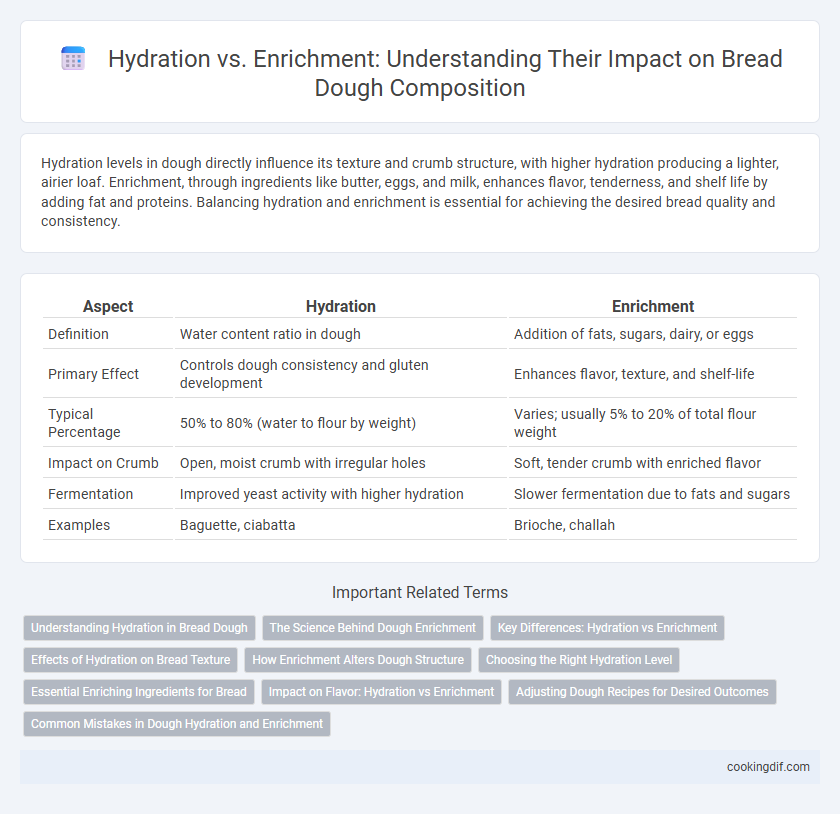Hydration levels in dough directly influence its texture and crumb structure, with higher hydration producing a lighter, airier loaf. Enrichment, through ingredients like butter, eggs, and milk, enhances flavor, tenderness, and shelf life by adding fat and proteins. Balancing hydration and enrichment is essential for achieving the desired bread quality and consistency.
Table of Comparison
| Aspect | Hydration | Enrichment |
|---|---|---|
| Definition | Water content ratio in dough | Addition of fats, sugars, dairy, or eggs |
| Primary Effect | Controls dough consistency and gluten development | Enhances flavor, texture, and shelf-life |
| Typical Percentage | 50% to 80% (water to flour by weight) | Varies; usually 5% to 20% of total flour weight |
| Impact on Crumb | Open, moist crumb with irregular holes | Soft, tender crumb with enriched flavor |
| Fermentation | Improved yeast activity with higher hydration | Slower fermentation due to fats and sugars |
| Examples | Baguette, ciabatta | Brioche, challah |
Understanding Hydration in Bread Dough
Understanding hydration in bread dough is essential for achieving the desired crumb texture and crust quality. Hydration, the ratio of water to flour by weight, directly influences gluten development, fermentation rate, and dough extensibility, with higher hydration levels typically resulting in a more open crumb and softer crust. Precise control of hydration is crucial for balancing dough elasticity and viscosity, ensuring optimal gas retention and oven spring during baking.
The Science Behind Dough Enrichment
Dough enrichment involves adding ingredients like fats, sugars, and dairy to enhance flavor, texture, and nutritional value, altering the dough's structure at a molecular level. Hydration, measured as the ratio of water to flour, directly affects gluten development and dough extensibility, impacting crumb softness and volume. The scientific balance between hydration and enrichment determines the dough's elasticity, fermentation rate, and final bread quality, with enriched doughs requiring adjusted hydration levels to compensate for additional enriching components.
Key Differences: Hydration vs Enrichment
Hydration in dough composition refers to the ratio of water to flour, directly affecting dough consistency, gluten development, and crumb texture. Enrichment involves adding ingredients like fats, sugars, eggs, or dairy to improve flavor, color, and nutritional value. Key differences lie in hydration controlling dough elasticity and moisture, while enrichment enhances taste and richness without altering the fundamental dough structure.
Effects of Hydration on Bread Texture
Higher dough hydration increases gluten development, resulting in a softer, more open crumb structure with larger air pockets. Elevated moisture levels enhance yeast fermentation, producing a lighter, more elastic bread texture. Conversely, lower hydration yields denser, chewier loaves with tighter crumb and less volume.
How Enrichment Alters Dough Structure
Enrichment ingredients such as fats, sugars, and dairy modify dough structure by weakening gluten development and increasing tenderness. These additions result in a softer crumb and enhanced flavor but reduce dough elasticity and extensibility compared to higher hydration doughs. Enriched doughs often require adjusted mixing and fermentation techniques to accommodate altered gluten matrix and moisture retention.
Choosing the Right Hydration Level
Selecting the right dough hydration level is crucial for bread texture, crumb structure, and baking performance. Higher hydration percentages, typically ranging from 70% to 85%, enhance gluten development and create an open, airy crumb, ideal for artisan breads like ciabatta and sourdough. Adjust hydration based on flour type and enrichment ingredients such as fats or sugars, which can reduce water absorption and require careful balancing to achieve optimal dough consistency.
Essential Enriching Ingredients for Bread
Essential enriching ingredients for bread, such as fats, sugars, and dairy products, significantly enhance dough texture, flavor, and shelf life. Hydration levels directly impact gluten development and dough elasticity, but enrichment ingredients contribute vital nutrients and improve mouthfeel. Optimizing the balance between hydration and enrichment ensures a tender crumb and enriched nutritional profile in the final bread product.
Impact on Flavor: Hydration vs Enrichment
Higher hydration levels in dough enhance gluten development and enzymatic activity, resulting in a more open crumb and complex tangy flavors due to increased fermentation byproducts like organic acids and alcohols. Enrichment with ingredients such as fats, sugars, and dairy products enriches the dough's flavor profile by adding sweetness, richness, and a tender crumb, often muting the sour notes produced during fermentation. Balancing hydration and enrichment allows bakers to tailor dough flavor, texture, and aroma to achieve desired sensory characteristics in bread.
Adjusting Dough Recipes for Desired Outcomes
Adjusting dough hydration levels influences crumb texture and crust crispness, with higher hydration producing open, airy crumbs and softer crusts. Enrichment through ingredients like eggs, butter, and sugar enhances flavor, moisture, and shelf life, resulting in richer, tender loaves. Balancing hydration and enrichment optimizes dough extensibility and fermentation, crucial for achieving specific bread characteristics.
Common Mistakes in Dough Hydration and Enrichment
Common mistakes in dough hydration include adding excessive water, leading to sticky, unmanageable dough, or insufficient water, causing dry, dense bread. In enrichment, overusing fats, sugars, or dairy can hamper yeast activity and dough rise, resulting in heavy, flat loaves. Accurate measurement and balancing hydration with enrichment ingredients are essential for optimal dough texture and bread quality.
Hydration vs Enrichment for dough composition Infographic

 cookingdif.com
cookingdif.com